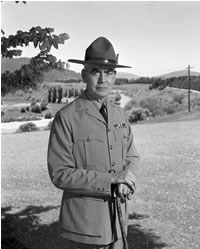 The story of Australia’s shortest-reigning Governor-General, William Shepherd Morrison (pictured in scout uniform), has been chosen by ArchivesACT as its August Find of the Month.
The story of Australia’s shortest-reigning Governor-General, William Shepherd Morrison (pictured in scout uniform), has been chosen by ArchivesACT as its August Find of the Month.
In a statement accompanying the Find, ArchivesACT said that since 1845 the churchyard at St John’s Anglican Church in Reid had been the resting place of Canberra’s most prominent citizens and family dynasties, but one of its most significant residents lived in the city for just one year.
“The churchyard at St John’s has officially been closed to burials since 1936, the Archives said.
“However, between 1920 and 1937, £2 could buy you an Exclusive Right of Burial Certificate, ensuring your final resting place would be the one you chose,” it said.
“Cash was not the only way into this exclusive enclave. The Cemeteries Ordinance of 1933 left specific provision for ‘such exceptions and qualifications as the Minister thinks fit’.”
It said this was fortunate, because in 1961 an extremely qualified candidate needed a place in the crowded churchyard.
William Shepherd Morrison, widely known as ‘Shakes’ for his habit of quoting Shakespeare, was born in Scotland in 1893 and entered the United Kingdom House of Commons, becoming Speaker before retiring due to ill-health in 1959.
Archives said it seemed quiet retirement did not suit him because the following year he became the 14th Governor-General of Australia with the peerage Viscount Dunrossil created for him.
However, ill-health continued to hound the Viscount with Lady Dunrossil often being called on to stand in for him at Vice-Regal events. He died aged 67, one year and a day after being sworn in.
It was the first time a Governor-General had died in office and Prime Minister, Sir Robert Menzies announced a State Funeral and the Governor-General’s wish to be buried in Australia. He was granted interment at St John’s Church.
However, discussions over what sort of gravestone should mark his resting place were still taking place 20 years later when the ashes of Lady Dunrossil were brought from the UK to take their place in the grave.
Original drawings clearly show the space intended for the additional interment, however, to the designers’ chagrin, rather than a flat surface, the vessel was placed vertically in front, and sits like a small footstool in front of an impressive headstone.





